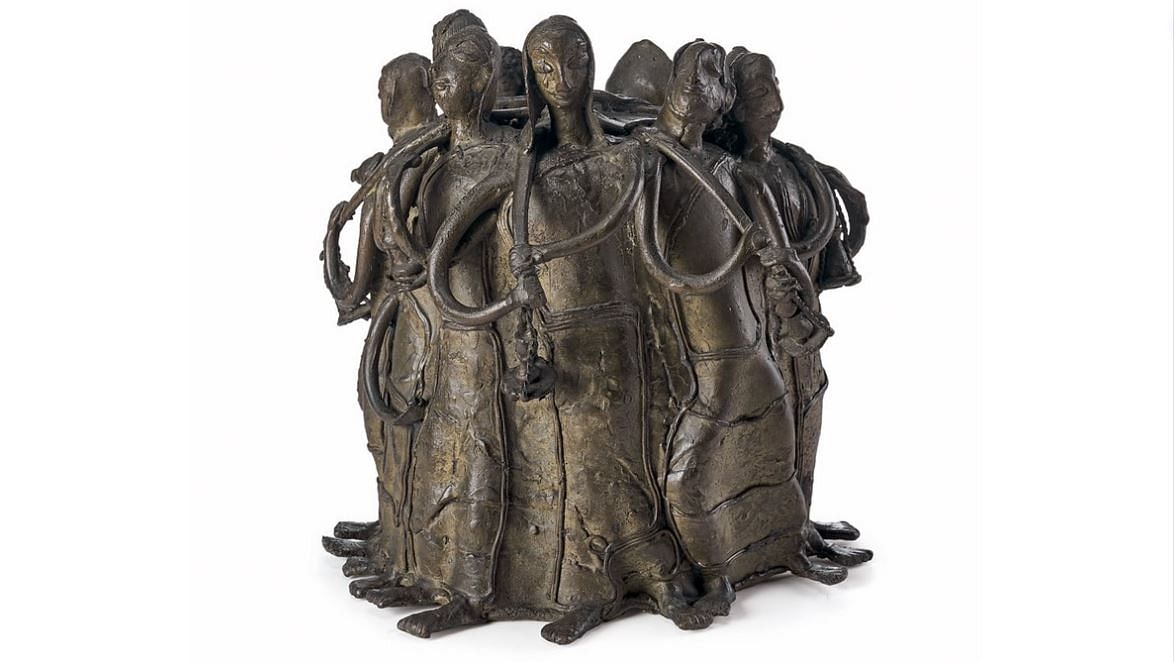
'Pilgrims to Haridwar'
Credit: Pundole's
Meera Mukherjee isn’t a name that generally appears in casual conversations about modern masters of Indian art, overwhelmingly dominated by artistic styles and the commercial success of just about a dozen artists. And what a pity that is. Long after her passing in 1998, Mukherjee remains one of India’s most important artists who made an indelible contribution to the evolution of ‘Indian modernity’, at a time when artists in a newly independent nation were fervently exploring ways to meld modernism with traditional ethos. Yet, her centenary last year — she was born in Calcutta in 1923 — went by without much fanfare.
By working closely with metal craftsmen of the country, Mukherjee — a pioneering sculptor — imbibed their aesthetic into her modern art practice, lending a flavour of modernism to indigenous sculpting traditions. And to say nothing of the fact that she was one of the earliest woman sculptors in an age when the field was almost exclusively a man’s world.
However, a small band of connoisseurs has been adding value to her work in the market as the auction results of the past few years have shown. Our knowledge gap in the understanding of her art too is being filled through exhibitions. One such show, ‘Outside In: Meera Mukherjee and Jaidev Baghel’, is currently running at the Museum of Art and Photography (MAP) in Bengaluru and is on till October 20.
Kolkata-based artist Adip Dutta, who grew up in the neighbourhood where Mukherjee lived, says, “Not much is known about her widely but having seen her as an artist since I was a teenager, I can say that she was unlike most other women of her time. Born in 1923, she stood up to practise her art; it was a revelation for me as it was so different from the gender-based roles that most women around me were made to play. She was in her sixties when I first met her, and the pull was magnetic. That’s because she was an accomplished individual — she came from a highly educated feudal Bengali family, wrote beautifully worded Bengali, spoke chiselled English and could hold a conversation in German as well.” The two went on to forge a lifelong artistic bond, which was celebrated in an exhibition, Adip Dutta & Meera Mukherjee: Nestled, at Experimenter Gallery, Kolkata in 2021.
Mukherjee trained at Abanindranath Tagore’s Indian Society of Oriental Art in Kolkata till her marriage at the age of 18. Post her divorce a few years later, she returned to the arts by studying at the Government College of Art and Craft, Calcutta, and Delhi Polytechnic. She went to Germany on a scholarship in 1953 to study at the Academy of Fine Arts, Munich. There, she worked under renowned sculptors Toni Stadler and Heinrich Kirchner; it was Stadler who inspired Mukherjee to transition to sculpting from painting. Upon her return to India, she was commissioned by the Anthropological Survey of India to document the practices of metal craftsmen of central India. This marked the beginning of her journey not just across the country but also to create a distinct body of work, which was as modern as it was traditional. It was her tryst with the Dhokra metal art of the Bastar tribals of Chhattisgarh — made through lost wax technique or cire perdue — that would eventually give birth to some of her most celebrated works.
It is this cross-cultural dialogue that forms the focus of the exhibition at MAP, juxtaposing works by Mukherjee alongside those by the Bastar artist Jaidev Baghel (1949-2014). According to MAP, it was Mukherjee’s encounters with Sriman Baghel (Jaidev Baghel’s father) that forged new pathways in her practice. Jaidev Baghel, on the other hand, gained renown with his experiments with both scale and form of the traditional technique, becoming a craftsperson and a modern artist at the same time.
According to Arnika Ahldag, head of exhibitions, MAP, “The exhibition sheds light on two artists who have been pushing the medium of metal casting, in their respective ways. Meera’s collaboration with women near Kolkata, nurturing their talents in textile art through kantha pieces, exemplifies her belief in collective creativity and empowerment. Similarly, Jaidev’s pioneering efforts in expanding the scope of Bastar Dhokra to the realms of modern and contemporary art led to transformative changes in Kondagaon.”
Those keeping track of Meera Mukherjee’s works at the auctions would clearly discern the impact of Dhokra art on her practice, where the artist created masterpieces in a seamless blend of tradition and modernity. An example is her bronze work, Pilgrims to Haridwar, which features a group of women in quintessential Dhokra stylisation. This work was sold for Rs 3 crore at a Pundole’s auction in August 2023, against an estimate of Rs 40-60 lakh. It remains Mukherjee’s most expensive work sold at auction, making her one of the top-selling Indian women artists of all time. The steadily rising prices of Mukherjee’s work, coupled with important academic exhibitions, inspire hope that this seminal artist will eventually get her due in the universe of Indian modern art.